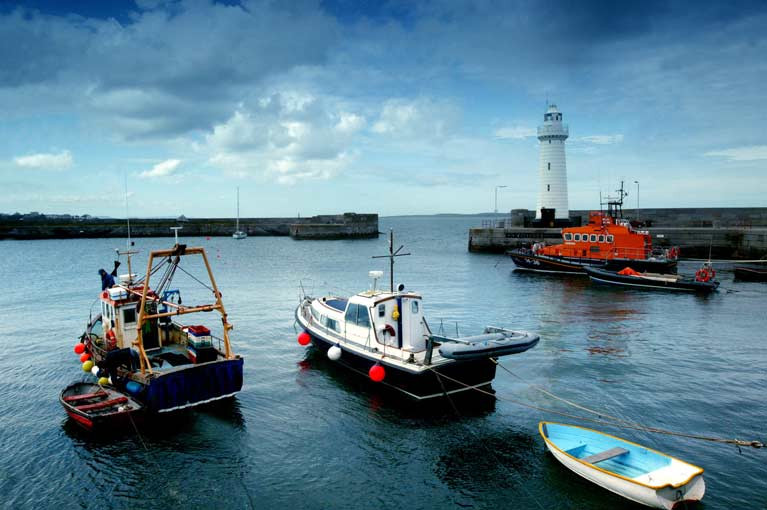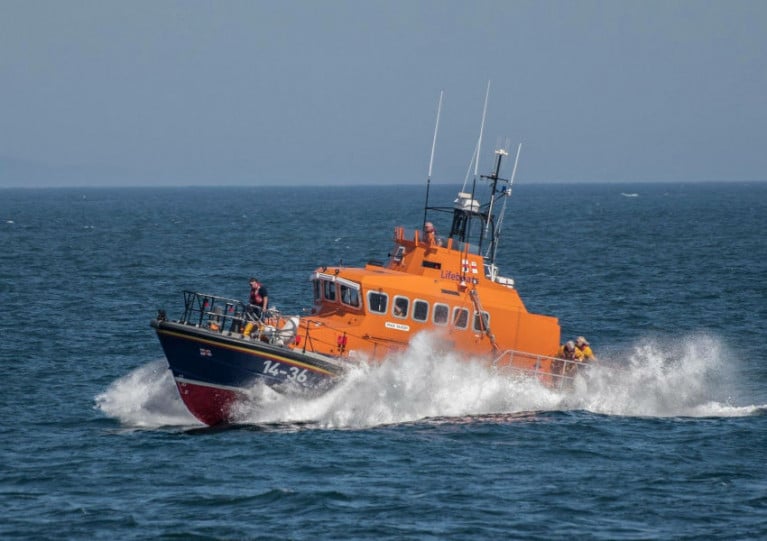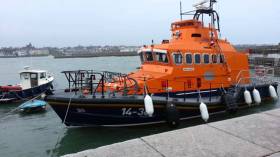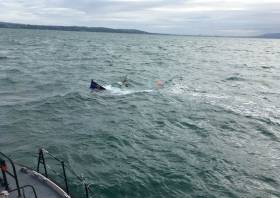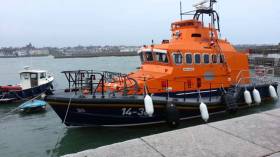Displaying items by tag: Donaghadee
Take a walk from Donaghadee Harbour east towards the Commons on the North Down coast and you’ll see the 70-year-old Sir Samuel Kelly lifeboat in its purpose-built shed near the Harbour.
Protected now from the elements, it is being restored by the Donaghadee Heritage Preservation Co. Ltd. in what has proved to be a long-term project.
Sir Samuel Kelly was a well-known Belfast coal importer and philanthropist whose widow bequeathed in 1950 to the RNLI the cost of a new lifeboat for Donaghadee. The vessel was named after Sir Samuel and today can be seen overlooking the North Channel where it made in 1953 probably its most famous rescue under Coxwain Hugh Nelson, when it saved 33 survivors of the sinking of the Stranraer – Larne car ferry, the MV Princess Victoria.
 Coxswain Hugh Nelson Photo: S Cochrane
Coxswain Hugh Nelson Photo: S Cochrane
Hugh Nelson was awarded the British Empire Medal for courage on that day. In I976 it became a reserve lifeboat stationed at the opposite end of Ireland at Courtmacherry on the County Cork coast. From there it saw action in the storm struck Fastnet yacht race in 1979.
 The Sir Samuel Kelly Lifeboat and crew Photo courtesy: County Down Spectator
The Sir Samuel Kelly Lifeboat and crew Photo courtesy: County Down Spectator
The 47 ft Watson class lifeboat was built by J Samuel & Co in Cowes and has two diesel engines. As a vessel that would often have to operate in dangerously shallow waters, the propellers are cleverly protected by the curved shape of the hull.
The Donaghadee Heritage Preservation Company is a not-for-profit charitable company, formed by local volunteers in Northern Ireland in 2015. It aims to advance and promote education, heritage, and culture, primarily by the conservation, rehabilitation, maintenance, and protection of the historic lifeboat Sir Samuel Kelly.
 Sir Samuel Kelly in its purpose made shelter
Sir Samuel Kelly in its purpose made shelter
On retirement, the lifeboat was bought by the Ulster Folk and Transport Museum at Cultra and arrived back in Northern Ireland in 1980. But funds had not been found to maintain and restore her and with the agreement of the museum the lifeboat was brought to Donaghadee. She was cleaned and painted before being left on display to the public in the Commons car park where she sat for 30 years.
After the formation of the Donaghadee Heritage Preservation Company in 2015 ownership of the boat was transferred to the local council’s North Down Museum and later the Company signed a loan agreement for the lifeboat with Ards and North Down Borough Council in addition to a lease for the compound in which it is located.
Chairman if the Donaghadee Heritage Company explains. “Three years ago, over the “Kelly” we erected a steel-framed shelter, clad in perspex and netting. This has allowed the Lifeboat to dry out after 70 years or more open to the elements, both at sea and at its current location ashore. This excellent structure has also enabled work to be done in relative comfort, sheltered from the worst of the weather. To date, it is our biggest and best investment!”.
Now the temporary shelter aims not only to reduce the destructive processes of the weathering that jeopardises the lifeboat's future and provide a base for the conservation work to take place but has allowed the creation of a new public interpretation space for the town to raise the profile of the longer-term project for which the vision is to exhibit the wider maritime heritage of Donaghadee.
A recent specialist survey highlighted the areas of the boat requiring attention and the Company is concentrating on these activities. Considerable funding will also be necessary to complete the conservation and refurbishment work over the coming years. Virtually all this work is done by volunteers, several of whom have experience in particular skills such as painting and metalwork.
Since the formation of Donaghadee Heritage Preservation Company, the Sir Samuel Kelly Project has enjoyed the support of the local community and Ards and North Down Borough Council. The Company, together with many local organisations has run events providing the funds for the shelter. The local council has been very supportive in facilitating the loan agreement for the lifeboat and the lease for the site. In addition, the parties have signed a Memorandum of Understanding, to work together to achieve a satisfactory outcome to the project. The aim is to provide a permanent home for the refurbished Sir Samuel Kelly and other exhibits in a Heritage Centre.
 Sir Samuel Kelly lifeboat Photo: National Historic Ships UK
Sir Samuel Kelly lifeboat Photo: National Historic Ships UK
Alan Couser anticipates another couple of years of work on the Sir Samuel Kelly Lifeboat to bring it up to museum standard. “We are already seeking out the possibilities of housing it in a permanent Heritage and Education Centre. Ideally, this would be built adjacent to the current Community Centre, which is close to the harbour. It would become a major attraction and centre of interest in that part of the town. Our team is currently in talks with consultants tasked with the redevelopment of the area and we believe we have a strong case. In the meantime, we continue to progress our work preserving the Lifeboat to the best of our ability, trusting it will last another 70 years and serve as a reminder of the lives saved and lost over her lifetime”.
Donaghadee Lifeboat Evacuates Sick Passenger From Cruise Ship
Donaghadee RNLI carried out a medevac of a passenger who became ill on a cruise ship that left Belfast Lough on Friday evening (17 September).
The volunteer crew were requested by Belfast Coastguard to launch their all-weather lifeboat Saxon shortly after 6pm and go to the aid of the female casualty.
The lifeboat launched at 6.12pm under coxswain Philip McNamara and seven crew members onboard and was on scene within half an hour. Weather conditions had a north-easterly Force 3 wind with calm seas and slight rain.
he lifeboat crew liaised with the ship and the ship’s doctor on the condition of the casualty before transferring the
After liaising with the ship and the ship’s doctor on the casualty’s condition, the RNLI crew transferred her onto the lifeboat and administer casualty care.
The lifeboat then proceeded to Bangor Marina with the casualty and another passenger, and once returned to shore the patient was transferred into the care of the Northern Ireland Ambulance Service.
Speaking following the callout, McNamara said: “We were glad to be able to help tonight and would like to wish the casualty a speedy recovery.
“I would also like to commend our volunteer crew who turned out so quickly in numbers this evening ensuring we could get our help to the casualty as soon as we could.”
Donaghadee Harbour Recreation Area Proposals Receive Mixed Response
The opinion is divided in Donaghadee about the Ards and North Down Borough Council plans to create within the harbour a 'recreational area' outside of the inner portion but still within harbour limits. The recreational area would be a safe area for non-motorised craft and swimmers to use, without fear of collisions with motorised craft.
Donaghadee Harbour lies on the north County Down coast and is a picturesque port in which the lifeboat Saxon has its home along with several boats on moorings and some small working fishing and tourist vessels. It has always been an irresistible attraction for those keen on jumping into and swimming in the sheltered (in most wind directions) waters.
At present, as well as those swimming within the harbour, many use the slipway to the west. The recreational area would be clearly identified on signage and demarcated by buoys throughout the bay.
 Donaghadee Harbour lies on the north County Down coast and is a picturesque port
Donaghadee Harbour lies on the north County Down coast and is a picturesque port
The Council says that all its harbours currently have restrictions in place to prohibit swimming within the inner harbour area where vessels may be manoeuvring. However, every summer the Harbour Master must continually challenge people who are either unaware of the restrictions or unwilling to abide by them. Donaghadee has a considerable number of daily kayakers and paddle boarders and the interestingly named Chunky Dunkers sea swimmers' group, who for the most part operate outside of the inner harbour and officers are keen to find a balance between the necessary safety considerations and the encouragement of these healthy activities.
It could be said that swimming in a restricted area isn't the same as the fun to be had jumping into the deep harbour!
In preparation for summer, officers wish to increase general awareness of the restrictions and hazards with the introduction of new, improved signage at all Council harbours. The signage will highlight potential hazards to harbour users and list all restrictions and prohibitions, such as swimming. It will also show the exact location using the "what3words" system.
Councillor Janice McArthur represents Donaghadee on the Council. Her attention was drawn to the fact that nowhere in the proposal does it mention that the recreational area dries out at low tide she replies, " Yes, that's a given.
However, people can, if competent, use the area beyond this. The key thing is that they do not use the working harbour space. The designated area, although tidal, is also a safe zone". She continued, "The use of paddleboards is becoming increasingly popular too so it provides a safe recreational area for this to take place. The proposal has received considerable support locally but Council officers will consult with stakeholders".
Regarding the slipway which is used by the sailing club, it was confirmed that craft launching from the jetty would have precedence.
And resident Robert Neill is cautious. " Swimmers really only go in at high tide (ie the Chunky Dunkers) so at least they are protected - don't think it will look very attractive".
John Caldwell, Hon Secretary of the Donaghadee Community Development Association, said, "The Association supports the idea. We want Donaghadee to be safely enjoyed by everyone, and the harbour and seafront are very popular with swimmers, kayakers and sailors. The harbour does, of course, need to continue to operate as a harbour and zoning off an area for recreational use strikes an appropriate balance between this and the needs of those wishing to take part in activities other than sailing."
Martin Strain of the Chunky Dunkers swim group says that " at this very early point we would give it a cautious welcome. Fundamental matters such as its precise area, how and who is going to 'police' it remain important issues that will ultimately determine the success or otherwise of the plan. However, generally speaking, we welcome any input or recognition by the Council that there is a burgeoning interest in water sports of all kinds in our town and that as ratepayers we are entitled to some Council funded facilities".
Donaghadee Harbour 200th Birthday Celebrations Set for August
Plans are afoot to celebrate the 200th anniversary of the building of the present harbour at Donaghadee, a small port on the north coast of County Down, but unearthing the Time Capsule, buried 24 feet below the pier during construction, will not, according to the County Down Spectator newspaper, be possible as the whole harbour has Industrial Heritage designation and Listed Building status which prohibits any disruption to the original structure.
The Bicentenary of the harbour will, Covid 19 restrictions and budget permitting, take place in early August this year. The port lies on the opposite side of the North Channel about 13 miles from Portpatrick on the Mull of Galloway in Scotland.
 Donaghadee has had a harbour since the mid-17th Century
Donaghadee has had a harbour since the mid-17th Century
Donaghadee has had a harbour since the mid-17th Century when the Scot, Sir Hugh Montgomery, an aristocrat and soldier, established a settlement in Ireland in 1606 (preceding the Plantation of Ulster) and claimed a share of the lands in North Down which had belonged to the last great Gaelic Lord, Con O'Neill.
 A David Kennedy painting of Donaghadee Harbour in 1834
A David Kennedy painting of Donaghadee Harbour in 1834
Montgomery had built a large stone quay to accommodate vessels ferrying between Donaghadee and Portpatrick with the main export from Ireland being cattle. But it became clear by the early 19th century that there were problems with both ports and after an exhaustive inquiry, it was concluded that "the passage between the two Kingdoms would be greatly facilitated and accelerated by the improvement of the harbours at Portpatrick and Donaghadee", thus giving the latter a new lease of life.
Plans and surveys for this ambitious undertaking were made by John Rennie Senior, the celebrated engineer whose works included Waterloo, Southwark and London Bridges on the River Thames. He died within two months of work beginning, and was succeeded by his son, John, later Sir John Rennie who worked with fellow Scot, the seasoned marine builder, David Logan.
 A coal boat in Donaghadee Harbour in the early 1950s
A coal boat in Donaghadee Harbour in the early 1950s
The new harbour had to have greater depth to accommodate steam packets. Rock blasted from the seabed, within the harbour area and further south in what became known as the Quarry Hole (now a small marina), was used to form the outer slopes of the two piers; but the inner faces were built of limestone from the quarries of Anglesea. The harbour consists of two independent piers running north-westwards out to sea; parallel nearer the shore, they converge at the outer ends to form a harbour mouth 150 feet (46 m) wide.
 Day trip boats for the Copeland Islands gather at Donaghdee Harbour
Day trip boats for the Copeland Islands gather at Donaghdee Harbour
John Caldwell of the Donaghadee Community Development Association is working very closely with the Ards and North Down Council on the detailed planning of the weekend. He said "I very much hope that we are able to celebrate the bicentenary of Donaghadee's iconic harbour in a meaningful way. The draft programme has something for everyone with a wide variety of activities aimed at people of all ages. It promises to be a super weekend".
Among the events planned are concerts, harbour sports such as kayaking, paddle boarding and coastal rowing as well as a Classic Yacht Regatta. And so it is hoped that this summer, the engineer John Rennie designed harbour, will be able to be celebrated, 200 years after the laying of the foundation stone on July 31st 1821.
Harbours & Slipways of Ards & North Down Reopen
Good news for those boaters keen to get back on the water in Ards and North Down in Northern Ireland.
All the Harbours and slipways operated by Ards and North Down Council will be open from this morning (Wed 27th May) following the easing of COVID-19 restrictions.
This action is in line with the NI Executive’s announcement last week regarding reopening access to certain outdoor activities, including water sports.
The council asks users to note that:-
- All harbour facilities will be operating with additional control measures designed to protect both staff and the public from exposure to, and transmission of, COVID-19 (more details are available at www.ardsandnorthdown.gov.uk/resident/harbours/introduction
- All those using the harbours for recreation are asked to adhere to social distancing guidelines and to be considerate to other users.
The harbours include Groomsport, Donaghadee, Ballywalter, Ballyhalbert and Cooke St Pier, Portaferry.
Donaghadee RNLI volunteers launched their all-weather lifeboat yesterday afternoon (Wednesday 6 May) after reports of three kayakers in difficulty off Cloughey in Co Down.
Following Covid-19 protocols, the volunteers of lifeboat Saxon made full speed to the location. However, en route they were informed that the kayakers had managed to reach shore themselves.
The lifeboat was then requested to retrieve the kayak, but as it was located in shallow water the lifeboat was stood down and returned to station.
Philip McNamara, Donaghadee RNLI coxswain, said later: “Whoever made the decision to call the coastguard did absolutely the correct thing.
“Situations can become precarious very quickly so the sooner we launch, the better for the casualty.”
Donaghadee RNLI’s volunteer lifeboat crew put to sea on Wednesday night (3 July) to rescue three adults and two children who had become stranded on the Copeland Islands following problems with their jetski.
The group had gone to the Co Down islands while the sun was still out but were stranded in the early evening when their jetski began to have mechanical issues.
They used a mobile phone to try and contact both Donaghadee and Bangor lifeboat stations before contacting a crew member on their mobile phone.
Paged at 7pm, the volunteers and made good speed in calm conditions in the RNLI Trent class lifeboat Saxon to Chapel Bay on the Big Copeland Island.
The lifeboat’s smaller XP boat, an inflatable tender carried by Saxon, was launched to go to the shore and bring the casualties to the warmth and safety of the larger lifeboat.
A towline was secured by the volunteer crew and the lifeboat returned to Donaghadee Harbour where the casualties were passed to the care of the coastguard.
Speaking following the callout, Donaghadee RNLI coxswain Philip McNamara said: “I feel we got to the casualties just on time, they were starting to feel the cold after spending quite sometime in the sunshine. They didn’t have any water to hydrate or clothing to keep them warm.”
In other news, Donaghadee’s crew joined tributes to an American couple with strong Northern Ireland roots for a generous $74,000 donation which will help the RNLI to continue saving lives at sea.
The late John Bradley, who grew up and worked in Co Tyrone, and his wife Sally Sue, who he met as a pen pal, donated $37,000 each to Bangor and Donaghadee lifeboat stations, while Tower Lifeboat Station, based next to Waterloo bridge in East London received $5,000.
John, who died on 1 July aged 81, leaves a lasting legacy to the RNLI, with the Bradleys’ donation to be used for vital volunteer crew kit and training.
Peter Irwin, Donaghadee RNLI lifeboat operations manager, said: “We are so grateful and would like to sincerely thank Sally Sue and John, and remember John for his amazing support of the RNLI. We are saddened to hear of John’s death and extend our sympathies to Sally Sue and the Bradley family.”
Bangor & Donaghadee Lifeboats Launch To Fishing Boat On Rocks
#RNLI - Two RNLI lifeboats were launched on Friday (31 August) at the request of Belfast Coastguard to assist a pleasure fishing boat with four people onboard off Carrickfergus.
Bangor RNLI was first to launch at 3.15pm to reports that a fishing boat had a fouled propeller and was taking on water while drifting ashore onto rocks near Carrickfergus.
Once on scene, the Bangor lifeboat crew established a towline and were able to pull the sinking boat off the rocks, as well as transfer two of its crew to the safety of the inshore lifeboat Jessie Hillyard, where they were given casualty care.
The remaining two fishermen were recovered on the shoreline by coastguard members.
Due to the vessel taking on too much water, the decision was taken to request the assistance of Donaghadee RNLI’s all-weather lifeboat and use its salvage pump to try and save the vessel.
Bangor cut their towline and proceeded to take the two casualties, who were wet and cold, to Carrickfergus and the care of the waiting coastguard crew.
Donaghadee’s volunteers were paged at 4.12pm and proceeded on their lifeboat Saxon at full speed to the last reported location of the sinking vessel.
Upon arrival, the fishing boat was already semi submerged and in the shipping lane, posing a danger to shipping traffic and local boats.
The crew were able to secure a line and tow the boat to shallow waters just north-east of Carrickfergus and prevent it becoming a danger to other boats. Unfortunately, the boat was unable to be recovered.
Speaking after the dual operation, Donaghadee RNLI coxswain Philip McNamara said: “Although unable to make it on time to save the fishing boat, the main concern is the safety of the crew members onboard. Thankfully the speedy response of our colleagues in Bangor ensured the people were brought to safety before the situation deteriorated any further.
“The crew member that requested assistance as soon as they realised they were in trouble did the right thing; the two crew members that made it ashore were very lucky to do so. If in difficulties it can be best to stay with your vessel as long as possible and avoid entering the water if you can.”
In other RNLI news from Northern Ireland, young members of Lough Erne Yacht Club went the extra mile for the lifesaving charity when they held a mini triathlon that raised £310 for Enniskillen Lifeboat Station, based at their club.
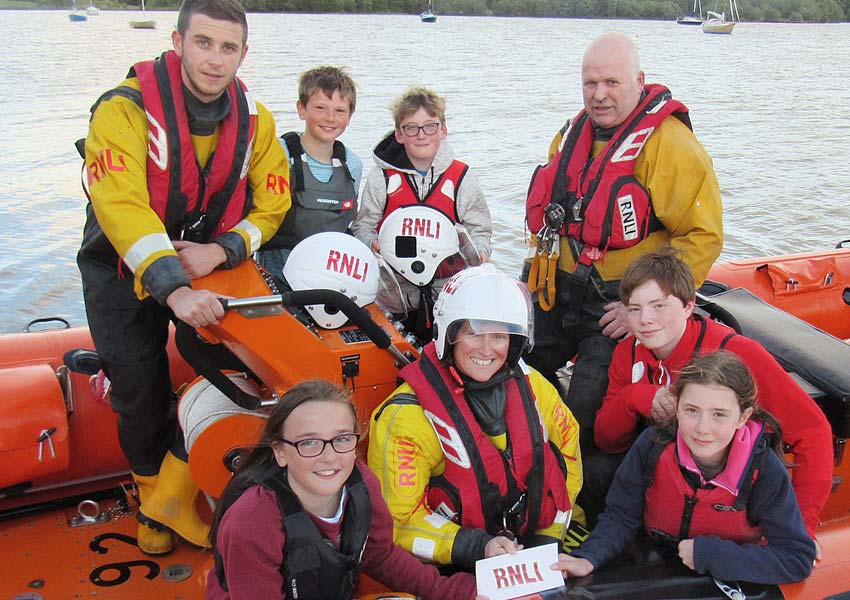
Emma Brines and Emily Torrens along with Peter Brines, Charlie Valentine and Adam Torrens presented the cheque to Lifeboat crew members Olivia Crosgrove, Padraig Lunny and helm Brian McAleer (photo by Bob Torrens). The young sailors thanked club members, family and friends for their support.
All Aboard For Donaghadee’s Lifeboat Festival This Weekend
#RNLI - Donaghdee RNLI has put together a packed itinerary for their forthcoming Lifeboat Festival this coming Saturday 28 July.
The popular maritime festival has gone from strength to strength each year, with locals and visitors exploring the maritime heritage of the beautiful Co Down town and availing of a range of fun activities.
The highlight of the festival will be the raft race, sponsored by Maxol Hightrees, which departs from the slipway opposite the sailing club at 11.45am.
Rafts can be hired for a four- or a six-person team but most groups prefer to construct their own.
Application forms can be obtained from the Lifeboat Shop, Dunn’s Footwear or on the Donaghadee RNLI website at donaghadeelifeboat.co.uk.
Other activities include a lifeboat exercise in the harbour (1pm), an open viewing of Donaghadee Lighthouse* (from noon to 4pm) and plenty of stalls for shopping (11am to 4pm). The lifeboat itself will also be open from 2pm to 4pm.
Commenting on the festival, Donaghadee RNLI lifeboat operations manager Peter Irwin said: “This day has become one of the key events in the Donaghadee social calendar and we are delighted to welcome so many visitors to our town.
“The Donaghadee lifeboat community has a rich history and was founded in 1910. This year the station marked the 65th anniversary of the Princess Victoria ferry disaster, following which a Bronze Medal for Gallantry was presented to the station’s coxswain for their role in the rescue of thirty-one people.
“We would love to welcome as many visitors as possible to the station and the surrounding harbour to let us show them what we do and express our gratitude for their support.”
* The viewing of the lighthouse is with kind permission of the Commissioner of Irish Lights, and visitors are advised that no children under 10 years of age can be admitted.
Donaghadee RNLI volunteer crew were paged three times over the weekend to assist a 24m fishing vessel which had run aground, a 31–ft yacht with three people onboard which had broken down and a small speedboat on the rocks at Millisle.
The first launch was requested by Belfast Coastguard on Saturday last (23 June) at 7.32pm following a 999 call by a member of the public reporting that a fishing vessel had run ashore on the north side of the ‘Perch’, located just of the Warren Road in Donaghadee.
Donaghadee RNLI’s all-weather lifeboat Saxon was on scene to the fishing vessel within five minutes. After consultation with the crew of the fishing vessel, which had five people onboard, and establishing that the boat had no damage, the crew of the 14m Trent class lifeboat attached a towline to the stern of the fishing boat to attempt to pull it off the rocks. The towline was then moved to the bow of the boat in another attempt to remove her from the rocks. With the assistance of the casualty vessel dropping its trawl doors to the seabed to jettison some weight, using both their bow thrusters and main propulsion to assist, the vessel came free and the lifeboat was able to tow it to deep water.
When the skipper of the fishing boat was satisfied that there was no obvious damage to the hull or propeller the towline was removed and retrieved and the vessel continued her passage south while the lifeboat returned to station.
The second launch of the weekend for the volunteer crew was when their pagers were alerted at 3.02pm at the request of Belfast Coastguard to assist 30ft yacht which had broken down approximately four nautical miles east of Donaghadee Harbour with three men onboard. The inboard auxiliary engine had failed so the crew established a towline and a course was set for Donaghadee were the yacht was secured at the visitors' berth by 4pm.
Five hours later at 8.03pm, the crew were paged again and requested to launch to assist a small speedboat with two people onboard on the rocks at Millisle. Launching the lifeboat at 8.10pm, Saxon proceeded at full speed to the scene as crew members readied the Trent class’s daughter boat to prepare to the need to get close to the shallow area where the casualty boat was stranded. As the lifeboat reached the area the Coastguard rescue team advised that a canoe in the vicinity had managed to tow the boat ashore and both the vessel and its crew were safe and well.
Speaking following what was a busy weekend for Donaghadee RNLI, Peter Irwin, Lifeboat Operations Manager said: ‘In the first call out of the weekend, our Coxswain and crew managed to refloat the fishing vessel just before high tide in difficult circumstances due to the restricted location of the grounding, size of the vessel and the direction the vessel was pointing. We were delighted to get her refloated relatively quickly and the intense training which the volunteer crew undertake regularly was of no doubt put into full practice. The further two calls on Sunday were more straightforward thankfully.
‘We would remind everyone going to sea and particularly as we approach the summer holidays and enjoy this good weather, to respect the water. Always wear a lifejacket, always carry a means of communication and tell someone ashore where you are going and when you are due back. Should you get into trouble dial 999 or 112 and ask for the Coastguard.’






























